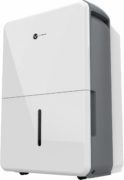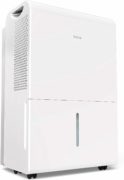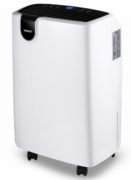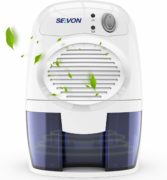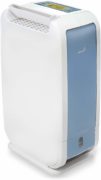List of the Best Dehumidifier
1. Vremi 1,500 Sq. Ft. Dehumidifier Energy Star Rated for Medium Spaces and Basements
Pros
- Covers up to 1,500 Sq. Ft. of space
- Controls excess moisture to get rid of mold and mildew
- Lightweight and portable so that you can leave it anywhere in the house
Cons
- The bucket may suffer from some design flaws
- Some units may also have working issues
Bottom Line
Despite some of its shortcomings, the Vremi 1,500 Sq. Ft. Dehumidifier is still the best dehumidifier within its ranks, outshining every other product in the same price range and range of features. It mostly delivers on its promise of providing a great living space in our homes by getting rid of all the allergens we don't want in our homes.
In the end, the Vremi 1,500 Sq. Ft. Dehumidifier is at the top of its competition, out-performing every other product in terms of removing excess moisture, working efficiently, having a portable design, and being easy to clean. By offering so many advantages, it can make customers forget about its flaws, and excuse it for the price tag that comes with it. Whether or not everyone agrees that this is the best dehumidifier out in the market, it is still our top choice for many reasons.
Read our in-depth Vremi 1,500 Sq. Ft. Dehumidifier Energy Star Rated for Medium Spaces and Basements Review here.
2. hOmeLabs 4,500 Sq. Ft Energy Star Dehumidifier
Pros
- This large dehumidifier covers up to 4,500 Sq. Ft. of space
- An auto-shutoff feature once the tank is full
- Removes moist, odor and other unhealthy things from your home
Cons
- May have problems with collecting water
- May suffer from prematurely breaking down
Bottom Line
The hOmeLabs 4,500 Sq. Ft Energy Star Dehumidifier could've had a shot at being at the top of its competition, but poor customer service paired with poor quality control has prevented this great dehumidifier from being the perfect addition to our homes. This company completely misses the mark on delivering excellent customer service by choosing to ignore their clients instead of helping them, which doesn't help the fact that some of their units are faulty.
In the end, the hOmeLabs 4,500 Sq. Ft Energy Star Dehumidifier provides us with enough positives to keep it from sinking lower in the ranks of the best dehumidifiers of this year. With its excellent features and its capability to purify wide spaces, it can undoubtedly deliver fantastic results for those who get a unit that functions the way it should.
Read our in-depth hOmeLabs 4,500 Sq. Ft Energy Star Dehumidifier Review here.
3. Yaufey 30 Pint Dehumidifier
Pros
- Covers up to 1,500 Sq. Ft. of space
- Combines efficiency and convenience
- Lightweight and portable so that you can leave it anywhere in the house
Cons
- May not produce the same results from other products like it
- May not deliver its promised results
Bottom Line
All in all, the Yaufey 30 Pint Dehumidifier is an excellent product that could've been made perfect with attention to detail. While it can give an exceptional experience for some customers, others feel that the product didn't deliver what it promised to them, which may lead to bitter disappointment. However, Yaufey counteracts this by providing 100% customer satisfaction guarantee and offers a 30-day money-back guarantee along with a 12-month free replacement and lifetime support.
So it's not all bad since Yaufey proves to be customer-driven when it comes to providing some compensation should their products fail to satisfy needs. However, it is best if they concentrate on improving their quality if they wish for their customers to get anything but the best experience.
Read our in-depth Yaufey 30 Pint Dehumidifier Review here.
4. SEAVON Electric Mini Dehumidifier
Pros
- Covers up to 1,500 Sq. Ft. of space
- Small and compact so you can put it anywhere in the house
- Easy to use and clean
Cons
- May have used false advertisement in some of its features
- May not always deliver the best results
Bottom Line
The SEAVON Electric Mini Dehumidifier puts up a great performance in many ways. However, it does lack a few details, which is why it hasn't reached perfection. By neglecting to address quality issues, it isn't able to deliver results that sweep us off our feet, but for its price tag, it is an excellent alternative for people looking for a more affordable option. It's also not the worst thing you can buy since more expensive dehumidifiers do less than what the SEAVON Electric Mini Dehumidifier can achieve while they charge for money.
In the end, the SEAVON Electric Mini Dehumidifier is still a product to look out for and should you see one, it's not a bad idea to pick it up. With excellent features and its compact design, you can take it anywhere with you to provide efficient dehumidifying on wet areas. And for $35 and the promise of a 2-year warranty, you're sure to get more than you lose, so why delay? Buy one now and see the SEAVON Electric Mini Dehumidifier experience for yourself.
Read our in-depth SEAVON Electric Mini Dehumidifier Review here.
5. Ivation 13-Pint Small-Area Desiccant Dehumidifier
Pros
- Can serve multiple purposes thanks to its desiccant technology
- Perfect for drying your laundry
- Portable with an easy-to-clean filter
Cons
- May have possible mechanical flaws that make it loud
- May develop issues over time
Bottom Line
The Ivation 13-Pint Small-Area Desiccant Dehumidifier is a good attempt at a multipurpose dehumidifier that can serve to eradicate mold and mildew, deodorizer, moisture extractor, dryer for wet laundry, and a condensation regulator. But even with all its uses, it isn't able to hide its only flaw, which proves to be a significant problem as it resonates throughout our homes.
However, given its many features, reasonable price tag, and excellent customer service, we can forgive this product's one shortcoming and include it as one of the best dehumidifiers of 2019. In the end, the Ivation 13-Pint Small-Area Desiccant Dehumidifier is a competent and versatile product that serves its purpose and more. Once Ivation catches up to customer feedback and provides a solution to its noise problem, there is no doubt it could be at the top of the list for the years to follow.
Read our in-depth Ivation 13-Pint Small-Area Desiccant Dehumidifier Review here.
